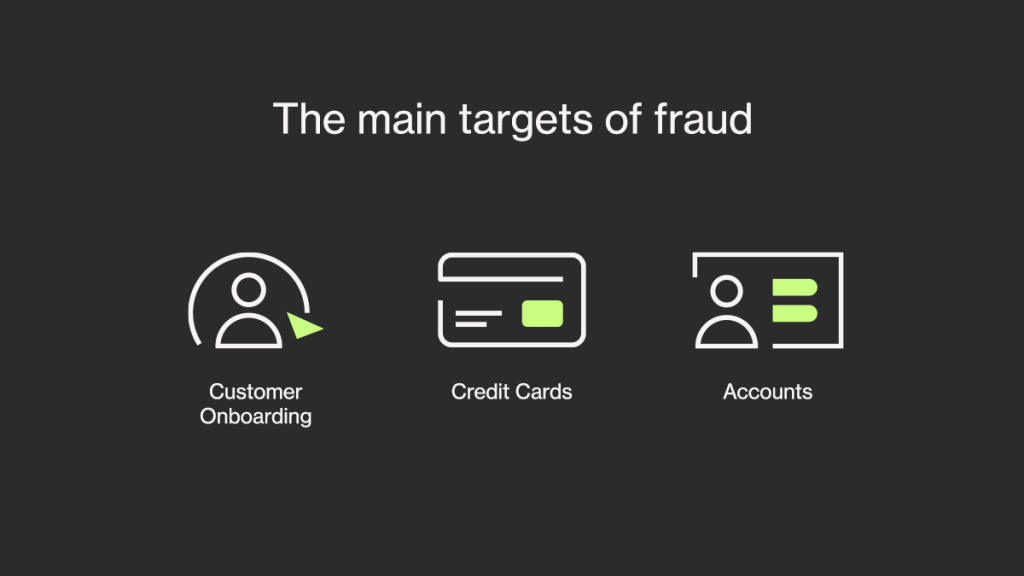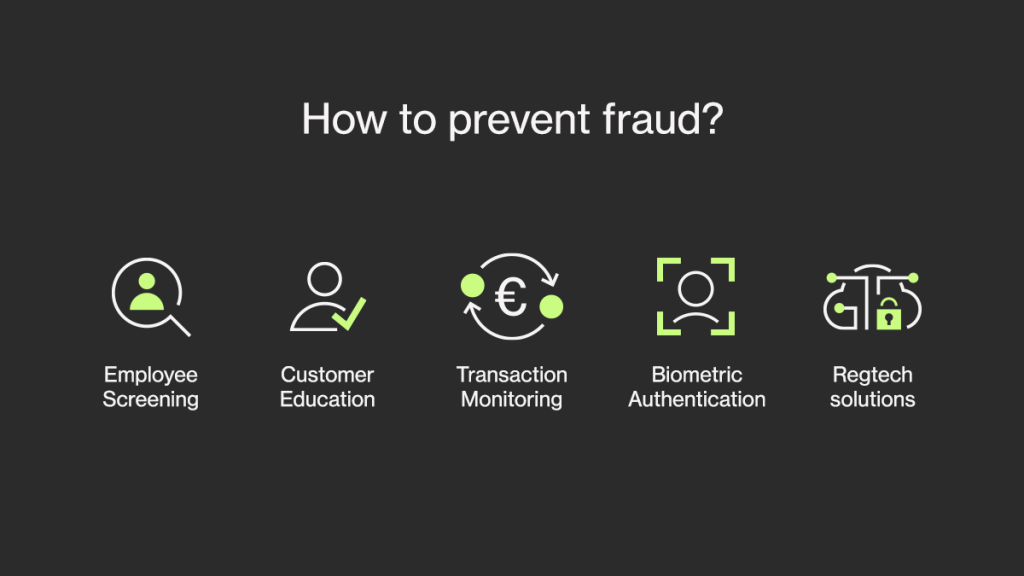Every institution in the banking sphere faces a common issue: fraud. It should come as no surprise that financial institutions attract more criminals than any other organization. The ability to immediately access and transfer funds prompts fraudsters to exploit banks for financial gain. According to a European Central Bank report, for example, thieves stole €1.8 billion through unauthorized credit card transactions.
While banks are aware of continuous and evolving fraud operations, many institutions fail to address the problem in a systematic manner. Criminals can slip between the cracks due to a lack of standardized high-tech solutions, poor AML practices, and ineffective manual processes.
This article examines the typical difficulties of fraud prevention in the banking industry and how to avoid them.
The Main Targets of Fraud in the Banking Sector

Fraudsters have devised numerous methods for committing fraud in the banking sector, yet tendencies are clear. To protect themselves from criminals, banks should implement the highest security for these targets: customer onboarding, credit card, and account protection.
Customer Onboarding Fraud
Customer onboarding is the process of verifying that clients are who they claim to be. By implementing rigid KYC and AML procedures, banks verify the clients’ identities and assess the risk score they may pose.
While there are a few methods to mislead a bank agent during an in-person application process, fraudsters get extra creative when it comes to digital onboarding. To deceive the system, they use fake, altered, or synthetic IDs as well as different spoofing artifacts such as 3D masks or deepfakes.
Regulators constantly impose new rules to prevent fraudulent activity, which results in a lengthened onboarding process. The situation poses a dilemma for banks: is it better to comply with regulation to the letter or lose customers?
Due to the time-consuming KYC process, many clients simply cut ties with the bank before completing the application. However, banks could leverage the situation by replacing manual processes that result in an 18-minute onboarding time with a digital solution.
Fast onboarding is a key component of the business models of neobanks and challenger banks. Many firms are increasingly using effective regtech solutions, like Ondato, to speed up the process. By using Ondato’s identity verification technology, banks can onboard clients in under 90 seconds.
Credit Card Fraud
In a single year, clients worldwide make about 370 billion credit card transactions. Banks screen the vast majority of them for suspicious behavior. Collecting various data points, for example, currency or transfer amounts, is an important aspect of the procedure. However, performing transaction monitoring manually is incredibly time-consuming and can result in a large number of false positives.
When banks use machine learning technology, AI learns unique client behavior patterns and can quickly spot unusual changes. Especially when paired with human input, AI can be the most effective solution for transaction monitoring.
Accounts Fraud
Banks are not always successful in preventing fraudsters from gaining access to their customers’ accounts. Criminals have devised several methods to obtain login information in order to steal other people’s money.
This type of crime, called account takeover fraud, is becoming increasingly prevalent, making AML and KYC measures more important than ever.
The issue raises an important concern about whether device authentication is still effective. Even though regulations require establishing person authentication, companies still use pins and passwords for returning clients.
The main reason device authentication such as a pin code is ineffective is that the data can be stolen and used by criminals to access the account. Meanwhile, person authentication uses biometric data unique to the individual that criminals struggle to falsify.
Common Fraud Tactics That Banks Face

As we already mentioned, fraudsters use many methods to succeed in their illicit activities. Let’s go through the most common fraud tactics the banking industry faces.
- Identity theft: Stealing someone else’s identity can have disastrous effects on both the bank and the client. According to Javelin’s 2021 Identity Fraud Survey, in 2020 alone, identity fraud resulted in a $13 billion loss.
- Account takeover fraud: Fraudsters utilize numerous strategies, such as phishing, to obtain their victims’ login information. The ultimate purpose of this attack is to get access to and manipulate a bank client’s account.
- Credential stealing: Also known as phishing, credential stealing is a common fraud tactic. In this case, a fraudster may pose as a trustworthy institution (often a bank’s representative) to trick an unsuspecting victim into giving away their logging credentials or other sensitive information. According to the 2020 Internet Crime Report, Americans lost more than $54 million in phishing scams.
- Money laundering: Criminals often use complex money transactions or shell companies to launder illegally gained funds. The process allows them to exchange the “dirty” money for legitimate currency. Money laundering almost always involves banking. Thus banks are responsible for screening and reporting any suspicious activity.
- Accounting fraud: This type of fraud happens when fraudsters imitate a banking client applying for a loan. By using a phantom firm, criminals falsify bank statements and send them to a bank. However, when the bank transfers the loan, criminals disappear without a trace with no intention of paying back the money.
- Account opening and onboarding: Fraudsters use various methods to fool banks during onboarding and account opening. The most common include bots, false IDs, and 3D spoofing masks. PayPal, the e-wallet provider, has recently suffered from this type of fraud. The scammers jumped on board once the company gave clients $5 or $10 for opening a PayPal or Venmo account. As a result, the company discovered almost 4.5 million fake accounts established by a large-scale bot network.
How to Prevent Fraud

Fraud prevention in the banking sector is an expensive and complex procedure. However, it can be simplified and improved by including several procedures such as employee screening, customer education, transaction monitoring, biometric authentication, and implementing a regtech solution.
Employee Screening
Having trustworthy employees is crucial to any institution, but banks may suffer additional consequences when the trust is breached. According to Clari5 research, 70% of banking fraud is successful because of insiders. That’s right, to successfully defraud a bank, fraudsters may turn to employees for help. Thus, it’s important to screen and audit everyone working for the organization.
Customer Education
Scams are often successful only because of unsuspecting customers. Sadly, many people are still unaware of fraudsters’ common tactics.
Educate your clients on various schemes through social media or by sending a press release.
Transaction Monitoring
Transaction monitoring is one of the most important aspects of the secure financial sector. Implementing an automated and efficient transaction monitoring solution can prevent financial crimes, such as money laundering and terrorist financing.
Biometric Authentication
Many organizations still use PINs and passwords to authenticate returning clients. However, the large-scale credential cracking many companies face proves these to be outdated security methods. Meanwhile, biometric authentication requires the client to be present during the process. It is incredibly complicated to pretend to be someone else. Thus, facial recognition and similar technologies minimize the risk of fraud.
Regtech Solutions
Banks simply cannot keep up with the enormous burden of ever-changing regulations. However, they have no choice but to comply, or they may face damage to their reputation or financial loss. Regtech solutions such as Ondato have been taking a load off the banking sector for a while now. Powered by the latest technology, the Ondato compliance platform can track fraudulent activity throughout the customer lifecycle. It saves time and resources, which are crucial to any organization attempting to secure its service.
Conclusion
From diminished reputation, loss of clients and funds to regulatory penalties – fraud can have devastating consequences for any financial institution. While some organizations still fail to implement effective strategies, regtech solutions are rising in popularity for their effectiveness. Implementing safety procedures and trusting all of your KYC needs to a compliance platform is a clever way to ensure regulatory compliance and business continuity.



